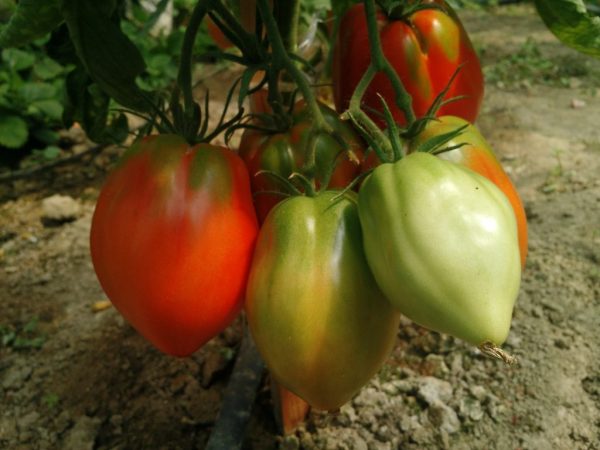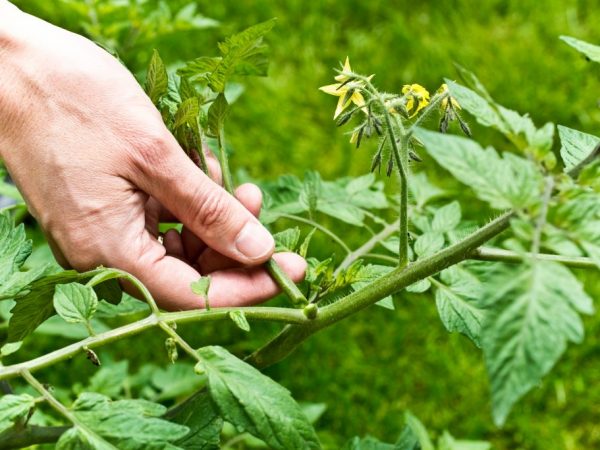Characteristics of the Eagle Heart tomato variety
Large-fruited varieties occupy the leading positions among tomatoes grown on individual household plots. Among the varieties with such distinctive qualities, it is worth highlighting the Eagle Heart tomato. The article provides a description of this variety.

Characteristics of the Eagle Heart tomato variety
Variety characteristic
The variety was bred in Russia by amateur breeders. Designed for growing in greenhouses. In the southern regions, it can be cultivated in the open field. It has an average ripening period, the first tomatoes ripen in 115-120 days from germination. They note its unpretentiousness in care and high stress resistance. Eagle Heart tomatoes are resistant to temperature fluctuations and changes in weather conditions.
The yield of the variety is high, but depends on the fertility of the soil. Under favorable conditions from 1 sq. M. you can collect 10-15 kg of tomatoes. Tomatoes are well stored and do not lose their presentation during transportation.
Description of the bush
Tomato variety Eagle Heart of indeterminate type, erect bushes, the growth of the central stem is unlimited, can reach 1.6 m in height. Stems are powerful, well developed, medium branched. The root system is fibrous with a large number of branches and small processes.
Leaves are medium-sized, even green, slightly pubescent, have an unpaired, intermittent-feathery shape, divided into lobes. On the inside, the leaf blade is light green with clear vein lines. Inflorescences begin to form above the third pair of leaves, in the form of bunches. On the peduncle, 5-7 flowers of a light yellow color develop.
Description of the fetus
In the internodes of this variety, 4-6 fruits ripen. Their average weight is 300-400g, some specimens can exceed 800g and reach record levels. The fruit has a beautiful red-pink color.
Fetal characteristics:
- the skin is dense with a glossy sheen;
- heart-shaped elongated end;
- slight ribbing is traced;
- the seed chambers (endocarpies) are small;
- the pulp is juicy with a slight graininess.
The fruits are distinguished by a sweetish taste and delicate structure without coarse fibers. It is highly appreciated in cooking, suitable for preparing various dishes, fresh salads and preserves.
Care
The description of the crop says that the cultivation of this variety does not require radically different agronomic techniques. In order for the Eagle Heart tomatoes to grow well, and the yield corresponded to the description, it will be enough to take care, as when growing any other variety. Plant care should include:
- garter;
- pinching;
- regular watering;
- feeding.
Garter and pinning

Grassing will increase the yield of plants
The description shows that this variety has an indeterminate type of growth and the growing technique involves the use of the method of pinching and tying to supports or trellises. These agronomic techniques will make plant maintenance easier and can increase yields.
Due to the fact that the bushes grow tall and the fruits are heavy, a garter is required.
- In the open ground, for such purposes, wooden stakes are used, which are driven into the ground next to the bushes immediately after planting the seedlings into the soil, and as the tomatoes grow, the stems and branches with fruits are attached.
- A more improved method is used in the greenhouse. The so-called mixed type of garter. A high support is placed near each bush, and a wire is horizontally fixed between them at different heights, the main stem is attached to the support, and side branches and branches with fruits are attached to the wire.
Growing on a trellis improves ventilation, simplifies maintenance and handling, and prevents injury to plants and clipping of branches under the weight of the fruit.
Pinching favorably affects the yield and size of the fruits. The method consists in removing the stepchildren (lateral stems) that grow in the leaf nodes. Eagle Heart is recommended to form in 2-3 stems. To do this, leave the lower well-formed and strong stepsons, and the rest are removed. This technique allows you to grow large and high-quality fruits without overloading the bush.
Watering
It is enough to water the bushes twice a week, in hot weather as the soil dries out. For this, warm settled water is used. Watering is carried out in the morning. It is better to add tomatoes to the root. It is important to remember that cold water and excess moisture can adversely affect the development of plants, as well as become a catalyst for the development of fungal diseases and rotting processes.
Top dressing
To fertilize tomatoes, root and foliar (spraying) dressings are made. They will provide plants with all the necessary trace elements and give strength for growth and fruiting.
During the development of tomatoes, three main root dressings are carried out:
- Two weeks after planting seedlings in the ground. A complex fertilizer is used. Fertilizers are dissolved in water and the bushes are watered. They also practice using chicken manure in the form of a low-concentration solution.
- During the period of mass flowering. Top dressing is done with phosphorus potassium fertilizers, or herbal infusions, as well as bone meal
- At the beginning of fruiting. Use the same fertilizers as during flowering.
Foliar dressing is carried out as additional in case of deficiency of certain nutrients.
Diseases and pests
The Eagle Heart variety is resistant to various fungal diseases.
In order to increase resistance and stability, treatment can be carried out using preparations that contain humic acids or enzymes. They have a good effect on the immune processes and prevent possible infections. If tomatoes are damaged by pathogenic bacteria, the bushes are treated with specialized means.
Tomatoes can be affected by aphids, white-winged, Colorado potato beetle, as well as ground pests such as a nematode, a bear. If aphids or whiteflies are found, the bushes are sprayed with a contact or systemic insecticide, this will help to quickly cope with pests. The Colorado potato beetle can be dealt with mechanically by removing insects from bushes, or by treating plants with specialized remedies.
Nematoda and Medvedka have the ability to cause serious damage to landings.
They live in the ground and primarily injure the roots, which can lead to the death of plants. To protect tomatoes when these types of pests are found, you need to loosen the soil near the plants well, and add an infusion of wormwood or garlic under the bushes. These funds will not destroy, but will be able to scare away. Disinfect the soil after harvesting.
Conclusion
The Eagle Heart tomato is resistant to various adverse factors, easy to care for with unique varietal characteristics, deserves the attention of every gardener practicing growing this crop.Good taste, wide culinary uses and consistent yields, the large pink fruits will pay off the little labor involved in growing these tomatoes.


